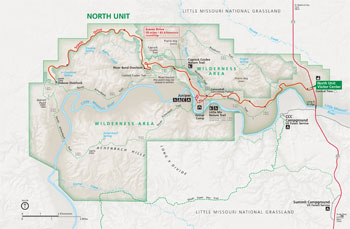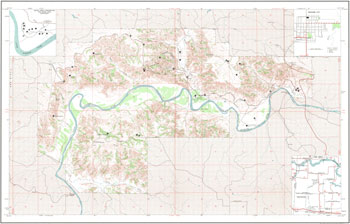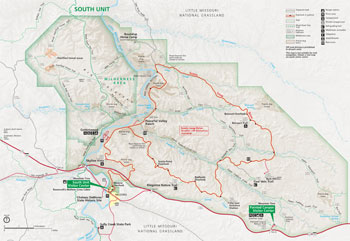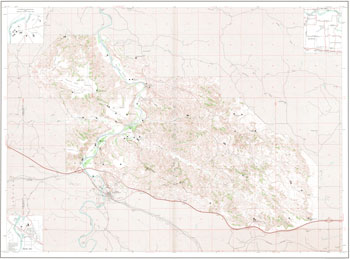|
Theodore Roosevelt National Park North Dakota |
 |
 NPS photo | |
I have always said I never would have been President if it had not been for my experiences in North Dakota.
—Theodore Roosevelt, 1918
Theodore Roosevelt first came to the Dakota Territory in 1883 to hunt bison. A year later, devastated by personal tragedy, he returned to grieve and lose himself in the vastness. He became a cattle rancher and, in this broken land, found adventure, purpose, wholeness. Though his ranch ultimately failed, his love for the rugged beauty of the land brought him back time and again for the rest of his life.
Roosevelt credited his Dakota experiences as the basis for his ground-breaking preservation efforts and the shaping of his own character. As president 1901-09, he translated his love of nature into law. He established the US Forest Service and signed the 1906 Antiquities Act, under which he proclaimed 18 national monuments. He worked with Congress to create five national parks, 150 national forests, and dozens of federal reserves—over 230 million acres of protected land.
Theodore Roosevelt National Park was not the great man's own creation. It was established in 1947 as a national memorial park to honor President Roosevelt and to provide a place for us to experience his beloved Badlands in our own ways.
My home ranch lies on both sides of the Little Missouri, the nearest ranch man above me being about twelve, and the nearest below me about ten, miles distant.
—Theodore Roosevelt, 1887
The Rugged Beauty of the Northern Plains
Over thousands of years, the Little Missouri River and its tributaries have cut through the soft sedimentary layers of the northern Great Plains. Flowing water—along with wind, ice, and plants—continue their erosive action. You can see land in transition throughout the park.
Are the Badlands really bad? For human travelers and farmers, perhaps. But bison and elk thrive with a choice of edible grasses—blue grama, western wheatgrass, buffalo grass, little bluestem, and needle-and-thread. Spring rains renew the grasslands and bring wildflowers' bright profusion. Prickly pear cactus delights hikers who might not think its habitat extends this far north.
Woody draws have stands of Rocky Mountain junipers, while the Little Missouri floodplain supports dense growths of cottonwoods and other shrubs. White-tailed deer forage in the river woodlands, while mule deer prefer broken country and uplands. Horses descended from ranch stock roam in the South Unit, as in Roosevelt's time. Prairie dogs, long a staple food source for many predators, live in "towns" in the grasslands. At home here, too, are nearly 200 bird species, many of them songbirds.
In the 1880s, Roosevelt witnessed overhunting overgrazing, and other threats to the natural world. Conservation increasingly became one of his major concerns. He would surely be gratified to know that through careful management, many animals that nearly became extinct are once again living here.
The bison is one such success story. They roamed the plains by the millions until the 1800s, when wholesale slaughter diminished their numbers to a few hundred. In 1956 a small herd was reintroduced here and has grown to the point where it has to be carefully managed. Elk, bighorn sheep, and pronghorn have also been reintroduced with success.
Working the Badlands
The Badlands saw human activity going back thousands of years, but because through-travel was difficult, there is little evidence of permanent settlement. In historic times Northern Plains tribes hunted the great bison herds.
When the railroad came to the Dakota Territory in the 1880s, people moved from the East and Midwest to try their hand at ranching. In 1883 Theodore Roosevelt invested in a local cattle operation known as the Maltese Cross Ranch, south of Medora.
The next summer, after both his wife and his mother died on February 14, he returned in search of healing and solitude. He started a second ranch, the Elkhorn. Roosevelt considered the Elkhorn his "home ranch" and spent most of his time here when in the Dakotas.
Roosevelt became a respected member of the ranching community. Today, this regional culture continues along with another commercial boom. Energy development surrounds the park. Round-the-clock drilling, pumping, and hauling oil and natural gas from the Bakken Shale formation takes place outside the park boundary.
The Badlands have never been an easy place to make a living. How will we meet today's challenge of balancing nature and human needs?
Exploring Theodore Roosevelt National Park
    (click for larger maps) |
Three Park Units The driving distance between the North and South units is 68 miles. The Elkhorn Ranch Unit is a 1½-hour drive from Medora.
Stay Safe, Protect the Park Federal law protects all natural and cultural features in the park. Do not collect or disturb objects. • Wild animals are dangerous and best viewed from a distance. For their sake and yours, do not approach or feed them. • Carry plenty of water when hiking. The park's natural water sources are not potable. • Pets must be leashed and are not allowed on trails. • For a complete list of regulations, including firearms policy, visit the park website.
Accessibility We strive to make our facilities, services, and programs accessible to all. For information, check at a visitor center, call, or visit the park website.
NORTH UNIT HIGHLIGHTS (CENTRAL TIME)
North Unit Visitor Center has exhibits, a short film, bookstore, and information about activities and road and trail conditions. Open daily in summer; winter hours can vary. Closed on Thanksgiving, December 25, and January 1.
14-Mile Scenic Drive The paved road starts at the entrance station; along the way are overlook pullouts and interpretive signs.
Longhorn Steers The park maintains this historic demonstration herd as a reminder of the Badlands cattle industry.
Cannonball Concretions Pullout These "cannonballs" were formed when sand grains from an ancient river deposit were cemented together by minerals dissolved in groundwater.
River Bend Overlook Take a short walk from the parking area to a view of the Little Missouri floodplain. The stone shelter was built in the 1930s by the Civilian Conservation Corps.
Oxbow Overlook Here, the Little Missouri takes a hard turn to east. The river originally continued north to Hudson Bay. During the most recent ice age, continental glaciers blocked its way, hence the turn.
SOUTH UNIT HIGHLIGHTS (MOUNTAIN TIME)
Painted Canyon Visitor Center and Overlook Here on the upper margin of the Badlands is a magnificent panorama of the broken topography in its colorful hues.
The visitor center, open May through October, has information and restrooms. Picnic tables are nearby.
South Unit Visitor Center has information, a theater, and a museum with natural history displays and some of Theodore Roosevelt's personal items. Open daily except Thanksgiving, December 25, and January 1.
Behind the visitor center, the Maltese Cross Cabin has been moved from its original location and restored. It is open for tours.
36-mile Scenic Loop Drive This paved drive has pullouts and interpretive signs.
Boicourt Overlook One of the best views of the Badlands in the park is from this overlook.
Peaceful Valley Ranch This complex spans the successive eras of the area's recent history. It was a ranch in the late 1800s, dude ranch in the 1920s, headquarters of the CCC and WPA in the 1930s, park headquarters in the 1950s and 60s, and facility for guided horseback rides until 2014.
ELKHORN RANCH UNIT (TIMELESS)
The Elkhorn Ranch Unit is the site of Roosevelt's beloved second ranch. The buildings no longer exist, but stones mark the foundation. Exhibit panels tell about ranch life and floodplain habitat.
Before going to the Elkhorn, ask for information at one of the visitor centers. The roads are unpaved, steep, and easily washed out by storms.
In 1884 Theodore Roosevelt hired Wilmot Dow and Bill Sewall to build and run the ranch. By mid-October Sewall and Dow had moved onto the site of the Elkhorn Ranch and were cutting and collecting cottonwood logs for the ranch house. Working through the winter, they completed the house by spring 1885.
The eight-room house stood 30 by 60 feet, with 7-foot-high walls. A porch hugged the east side. Dow and Sewall built several more buildings: two stables with a connecting roof; cattle shed; chicken house; and blacksmith shop.
By 1887 drought and blizzards had destroyed Roosevelt's herds. He gave up ranching and moved permanently back to New York to continue his political career.
Source: NPS Brochure (2015)
|
Establishment
Theodore Roosevelt National Park — November 10, 1978 |
For More Information Please Visit The  OFFICIAL NPS WEBSITE |
Documents
Acoustic Monitoring Report: Theodore Roosevelt National Park NPS Natural Resource Report NPS/NRSS/NSNS/NRR-2016/1206 (Scott D. McFarland, May 2016)
Aquatic Resources along the Little Missouri River near Theodore Roosevelt National Park, North Dakota NPS Natural Resource Technical Report NPS/NGPN/NRTR-2013/777 (Lusha Tronstad, July 2013)
At the Open Margin: The NPS's Administration of Theodore Roosevelt National Park (HTML edition) (David Harmon, 1986)
Baseline elemental-composition of selected plants and soils, and assessment of airborne element contamination, Theodore Roosevelt National Park, North Dakota USGS Open-File Report 85-251 (L.P. Gough, J.L. Peard, R.C. Severson, L.L. Jackson, B.F. Arbogast, J.M. Motooka, S.W. Snow, E.E. Engleman and J.P. Bennett, 1985)
Boundary Expansion Study Environmental Assessment, Theodore Roosevelt National Park Public Review Draft (engineering-environmental Management, Inc., November 2002)
Cowboy Dress, Arms, Tools and Equipment as used in the Little Missouri Range Country and the Medora Area in the 1800's (Don Rickey, Jr., 1957)
Cultural Affiliation Statement and Ethnographic Resource Assessment Study for Knife River Indian Villages National Historic Site, Fort Union Trading Post National Historic Site, and Theodore Roosevelt National Park, North Dakota Final Report (Maria Nieves Zedeño, Kacy Hollenback, Christopher Basaldú, Vania Fletcher and Samrat Miller, December 8, 2006)
Cultural Landscape Report: Peaceful Valley Ranch, Theodore Roosevelt National Park, Medora, North Dakota (Commonwealth Heritage Group, Inc. and Historic Resources Group, Inc., June 2019)
Effects of Climate Change and Atmospheric Nitrogen Deposition on Forest Understory Vegetation Communities in Selected U.S. National Parks NPS Science Repport NPS/SR-2024/169 (Todd C. McDonnell, Brian Knees, Michael D. Bell and Emmmi Felker-Quinn, August 2024)
Elk Movements, Habitat Use, and Population Dynamics in Theodore Roosevelt National Park (Jerry A. Westfall, Jr., Lynn R. Irby, Clayton B. Marlow and Harold D. Picton, October 1989)
Flood analysis along the Little Missouri River within and adjacent to Theodore Roosevelt National Park, North Dakota USGS Water-Resources Investigations Report 86-4090 (D.G. Emerson and Kathleen Macek-Rowland, 1986)
Foundation Document, Theodore Roosevelt National Park, North Dakota (April 2014)
Foundation Document Overview, Theodore Roosevelt National Park, North Dakota (May 2014)
Furnishing Plan for a Badlands Ranch House, Theodore Roosevelt National Memorial Park (Lenard E. Brown, October 31, 1969)
General Management Plan/Development Concept Plans, Theodore Roosevelt National Park, North Dakota (June 1987)
Geologic Resource Evaluation Report, Theodore Roosevelt National Park NPS Natural Resource Report NPS/NRPC/GRD/NRR-2007/006 (K. KellerLynn, June 2007)
Geology and Coal Valuation of W½ Sec. 9, T. 140 N., R. 102 W., South Roosevelt State Park, North Dakota (Carroll H. Wegemann, November 28, 1938)
Geology of the North Unit, Theodore Roosevelt National Memorial Park (HTML edition) (Wilson M. Laird, reprint from North Dakota History vol. 23 no. 42, April 1956)
Habitat Use and Distribution of Bison in Theodore Roosevelt National Park (©Jack Eugene Norland, Master's Thesis Montana State University, December 1984)
Historic Resource Study: Theodore Roosevelt National Park (Mark Fiege, Janet Ore and Orsi, January 10, 2017)
Historic Structures Report, Historical Data Section: CCC Structures, Peaceful Valley Ranch, Maltese Cross Cabin, Elkhorn Ranch, Theodore Roosevelt National Park, North Dakota (Louis Torres, September 1980)
Information and Hiking Guide: 2018
Livestock Plan Environmental Assessment, Theodore Roosevelt National Park, North Dakota (September 2023)
Management of Plains Cottonwood at Theodore Roosevelt National Park, North Dakota NPS Natural Resource Report NPS/THRO/NRR-2017/1395 (Jonathan M. Friedman and Eleanore R. Griffin, February 2017)
Management Plan for Longhorn Cattle, Theodore Roosevelt National Memorial Park, North Unit (Henry A. Schoch, October 12, 1970)
Master Plan, Theodore Roosevelt National Memorial Park, North Dakota (1973)
National Register of Historic Places Nomination Form
Peaceful Valley Ranch (Dori M. Penny, Thomas K. Larson and Kathy McKoy, May 1993, revised April 1994)
Natural Resource Condition Assessment, Theodore Roosevelt National Park NPS Natural Resource Report NPS/THRO/NRR-2014/776 (Shannon Amberg, Kathy Kilkus, Mike Komp, Andy Nadeau, Kevin Stark, Lindsey Danielson, Sarah Gardner, Eric Iverson, Eric Norton and Barry Drazkowski, February 2014)
Optimum Carrying Capacity for Bison in Theodore Roosevelt National Park (Clayton B. Marlow, Lynn L. Irby and Jack E. Norland, November 1984)
Paleontological Resource Inventory (Public Version), Theodore Roosevelt National Park NPS Natural Resource Report NPS/THRO/NRR—2022/2385 (Charles J. Salcido, Patrick Wilson, Justin S. Tweet, Blake E. McCann, Clint A. Boyd and Vincent L. Santucci, May 2022)
Park Newspaper: 1990-1991 • 1991-1992 • 2009 • 2010 • 2011 • 2012 • 2014 • 2015 • 2016 • 2017
Peaceful Valley Ranch: An Extended History (Dori M. Penny and Thomas K. Larson, April 1993)
Plant Community Composition and Structure Monitoring Protocol for the Northern Great Plains I&M Network Version 1.01 NPS Natural Resource Report NPS/NGPN/NRR-2012/489 (Amy J. Symstad, Robert A. Gitzen, Cody L. Wienk, Michael R. Bynum, Daniel J. Swanson, Andy D. Thorstenson and Kara J. Paintner-Green, February 2012)
Plant Community and Composition and Structure Monitoring Annual Reports: 2011 • 2012 • 2013 • 2014 • 2011-2016 • 2017 • 2018
Rangeland Health Assessment of Theodore Roosevelt National Park NPS Natural Resource Report NPS/THRO/NRR-2023/2580 (Alexandra Stoneburner and Jordan Spaak, October 2023)
Roosevelt and the Stockmen's Association (Ray H. Mattison, extract from North Dakota History, Vol. 17 No. 2, April 1950, ©State Historical Society of North Dakota)
Roosevelt and the Stockmen's Association (Ray H. Mattison, extract from North Dakota History, Vol. 17 No. 3, July 1950, ©State Historical Society of North Dakota)
Roosevelt's Dakota Ranches (Ray H. Mattison, extract from North Dakota History, Vol. 22 No. 4, October 1955, ©State Historical Society of North Dakota)
Roosevelt's Elkhorn Ranch (Ray H. Mattison, extract from North Dakota History, Vol. 27 No. 2, Spring 1960, ©State Historical Society of North Dakota)
South Unit Loop Road Reconstruction Project Environmental Assessment, Theodore Roosevelt National Park (February 2022)
South Unit Loop Road Reconstruction Project Newsletter, Theodore Roosevelt National Park (2022)
Spring Types and Contributing Aquifers from Water-Chemistry and Multivariate Statistical Analyses for Seeps and Springs in Theodore Roosevelt National Park, North Dakota, 2018 USGS Scientific Investigations Report 2020-5121 (Colton J. Medler and William G. Eldridge, 2020)
Statement for Management: May 1992 • November 1994
The Geologic Story of the Great Plains USGS Bulletin 1493 (Donald E. Trimble, 1980, reprinted 1990)
The Geology of the South Unit, Theodore Roosevelt National Memorial Park (HTML edition) (Wilson M. Laird, reprint from North Dakota History vol. 17 no. 4, October 1950)
The History of the Dakota Prairie Grasslands: An Overview (Thomas J. Turck, 2011)
The History of Theodore Roosevelt National Memorial Park (©Dale J. Strand, Master's Thesis University of North Dakota, August 1962)
The Road Inventory of Theodore Roosevelt National Park (September 1998)
Theodore Roosevelt and the Dakota Badlands: Historic Handbook (Chester L. Brooks and Ray H. Mattison, 1958, reprint 1962)
Theodore Roosevelt and the Dakota Badlands: Historic Handbook (HTML edition) (Chester L. Brooks and Ray H. Mattison, 1958, rev. 1983)
Topographic Map: Theodore Roosevelt National Memorial Park, North Unit, ND Scale: 1:24,000 (USGS, 1975)
Topographic Map: Theodore Roosevelt National Memorial Park, South Unit, ND Scale: 1:24,000 (USGS, 1975)
White-Nose Syndrome Surveillance Across Northern Great Plains National Park Units: 2018 Interim Report (Ian Abernethy, August 2018)
Wild Horse Management Plan: Theodore Roosevelt National Memorial Park (June 1970)
Wilderness Proposal, Theodore Roosevelt National Memorial Park Preliminary (September 1970)
thro/index.htm
Last Updated: 28-Mar-2025